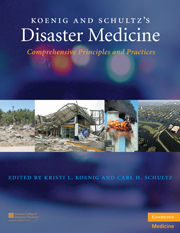Book contents
- Frontmatter
- Contents
- List of Contributors
- Contributor Biographies
- Foreword
- Preface
- Acknowledgments
- PART I CONCEPTUAL FRAMEWORK AND STRATEGIC OVERVIEW
- PART II OPERATIONAL ISSUES
- PART III CLINICAL MANAGEMENT
- SECTION A CBRNE AND HAZMAT
- 26 Explosive Events
- 27 Burn Patient Management
- 28 Clinical Aspects of Large-Scale Chemical Events
- 29 Biological Events
- 30 Nuclear and Radiological Events
- 31 Hazardous Material, Toxic, and Industrial Events
- SECTION B ENVIRONMENTAL EVENTS
- Index
- Plate section
- References
29 - Biological Events
from SECTION A - CBRNE AND HAZMAT
Published online by Cambridge University Press: 05 August 2011
- Frontmatter
- Contents
- List of Contributors
- Contributor Biographies
- Foreword
- Preface
- Acknowledgments
- PART I CONCEPTUAL FRAMEWORK AND STRATEGIC OVERVIEW
- PART II OPERATIONAL ISSUES
- PART III CLINICAL MANAGEMENT
- SECTION A CBRNE AND HAZMAT
- 26 Explosive Events
- 27 Burn Patient Management
- 28 Clinical Aspects of Large-Scale Chemical Events
- 29 Biological Events
- 30 Nuclear and Radiological Events
- 31 Hazardous Material, Toxic, and Industrial Events
- SECTION B ENVIRONMENTAL EVENTS
- Index
- Plate section
- References
Summary
The opinions and assertions contained herein are the private views of the authors and are not to be construed as official or as necessarily reflecting the views of the Department of Defense, the U.S. Department of Health and Human Services, or any of their component institutions.
OVERVIEW
A Brief History of Biological Warfare
Biological warfare is ancient in its origins, dating back at least as far as 1346. In that year, Tatar invaders laid siege to the city of Kaffa, in present-day Ukraine. When an outbreak of bubonic plague afflicted the Tatar invaders, they catapulted bodies of their own victims over the city walls in an attempt to intentionally spread plague within the city. The plan appeared to succeed. Genoese and Venetian merchants stranded within the city contracted plague, fled the city, sailed home, and took the disease with them, thus firmly establishing the “Black Death” in continental Europe. Current understanding suggests that the catapults fail to explain the extension of plague into Kaffa. Bubonic plague is now known to be transmitted by fleas, which rapidly abandon the cooling cadaver, making it unlikely that these corpses would remain infectious. Similarly, the American experience with biological warfare dates back at least as far as 1763. During the French and Indian Wars, the British Colonial Commander, Sir Jeffrey Amherst, allegedly ordered the use of smallpox-laden blankets presented as gifts to his Native American adversaries, apparently resulting in outbreaks of smallpox among these natives.
Keywords
- Type
- Chapter
- Information
- Koenig and Schultz's Disaster MedicineComprehensive Principles and Practices, pp. 454 - 476Publisher: Cambridge University PressPrint publication year: 2009
References
- 2
- Cited by



